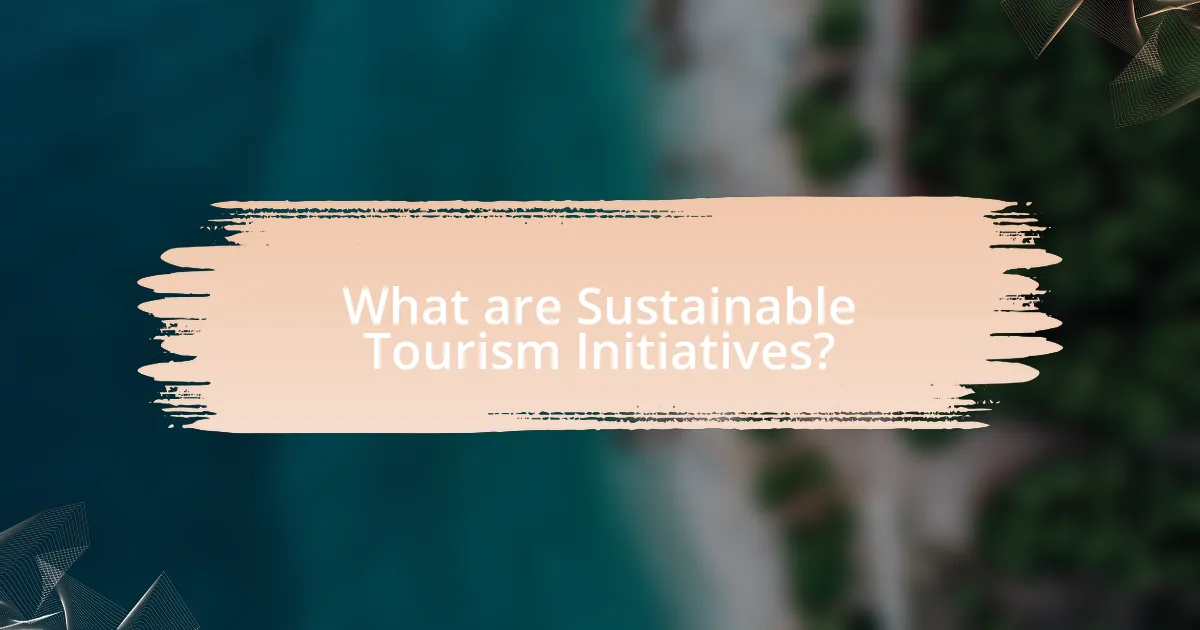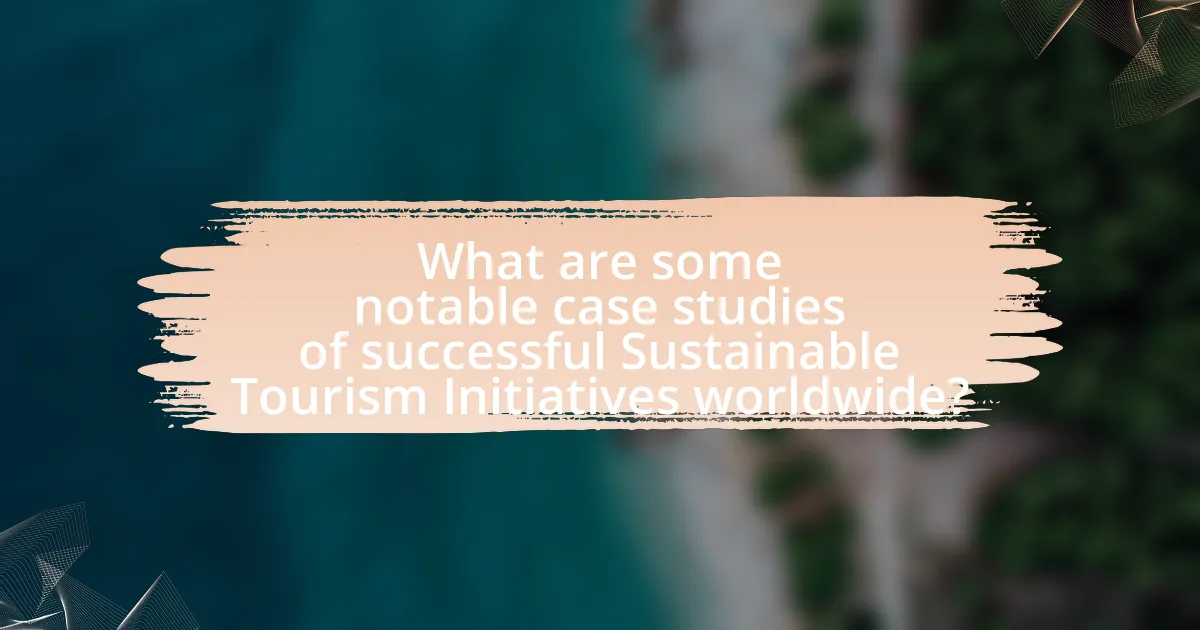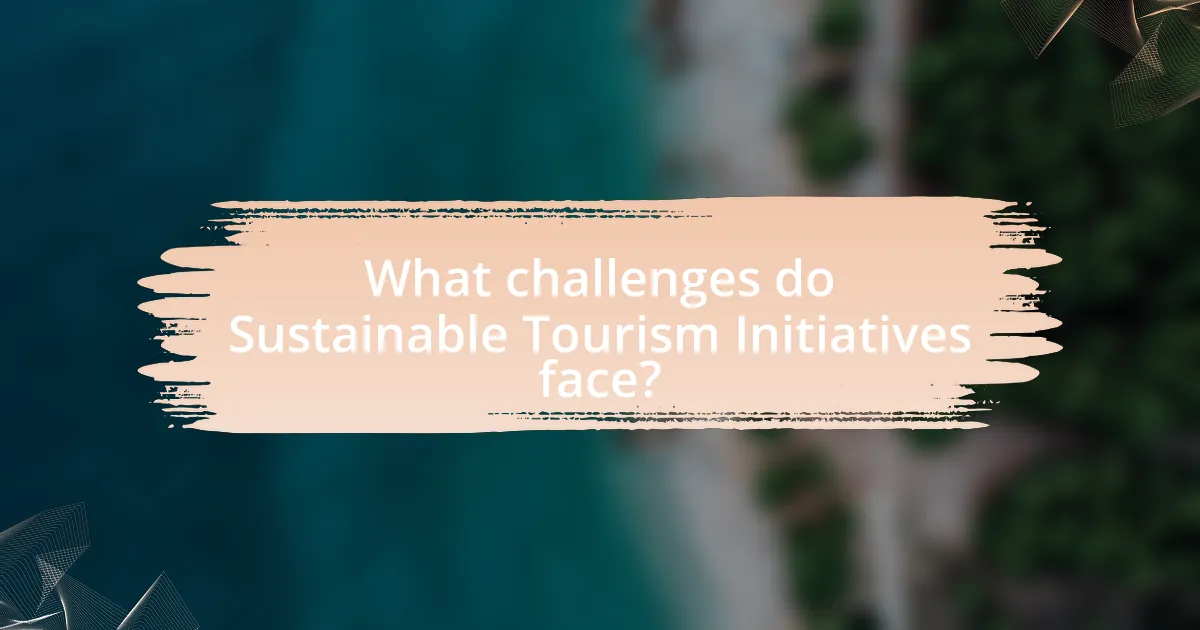Sustainable tourism initiatives are strategies designed to reduce the negative impacts of tourism on the environment, culture, and economy while enhancing benefits for local communities. This article examines notable case studies of successful sustainable tourism practices worldwide, including Costa Rica and Bhutan, highlighting their approaches to environmental conservation, community involvement, and economic viability. Key components such as stakeholder collaboration, effective government policies, and the role of technology in promoting sustainability are discussed, along with the challenges faced in implementing these initiatives. The article emphasizes the importance of balancing tourism growth with cultural preservation and ecological integrity to ensure long-term benefits for both travelers and host communities.

What are Sustainable Tourism Initiatives?
Sustainable tourism initiatives are strategies and practices aimed at minimizing the negative impacts of tourism on the environment, culture, and economy while maximizing benefits for local communities. These initiatives often include measures such as promoting eco-friendly accommodations, supporting local economies through the use of local resources, and implementing conservation efforts to protect natural and cultural heritage. For example, the Global Sustainable Tourism Council (GSTC) provides criteria for sustainable tourism practices, which are adopted by various destinations to ensure responsible tourism development.
How do Sustainable Tourism Initiatives differ from traditional tourism?
Sustainable tourism initiatives prioritize environmental conservation, cultural preservation, and community well-being, whereas traditional tourism often focuses primarily on economic gain and visitor satisfaction. Sustainable tourism aims to minimize negative impacts on ecosystems and local cultures by promoting responsible travel practices, such as reducing carbon footprints and supporting local economies. For example, according to the United Nations World Tourism Organization, sustainable tourism can lead to a 30% reduction in carbon emissions compared to traditional tourism practices. This approach fosters long-term benefits for both travelers and host communities, contrasting with traditional tourism’s short-term profit motives.
What principles define Sustainable Tourism Initiatives?
Sustainable tourism initiatives are defined by principles that prioritize environmental conservation, cultural preservation, and economic viability. These principles include minimizing environmental impact through responsible resource use, promoting local culture and heritage, and ensuring that tourism benefits local communities economically. For instance, the Global Sustainable Tourism Council outlines criteria such as reducing carbon footprints, supporting local economies, and respecting cultural authenticity, which are essential for fostering sustainable tourism practices.
Why is sustainability important in the tourism sector?
Sustainability is important in the tourism sector because it ensures the long-term viability of natural resources and local communities while enhancing the travel experience. Sustainable tourism practices help to minimize environmental impact, preserve cultural heritage, and promote economic benefits for local populations. For instance, according to the United Nations World Tourism Organization, sustainable tourism can contribute to the achievement of the Sustainable Development Goals by fostering responsible consumption and production patterns, which ultimately leads to a more resilient tourism industry.
What are the key components of successful Sustainable Tourism Initiatives?
The key components of successful Sustainable Tourism Initiatives include community involvement, environmental conservation, and economic viability. Community involvement ensures that local populations have a voice in tourism development, fostering cultural preservation and social equity. Environmental conservation focuses on minimizing ecological impact through responsible resource management and promoting biodiversity. Economic viability guarantees that tourism generates sustainable income for local communities while supporting infrastructure and services. These components are essential for creating a balanced approach that benefits both tourists and host communities, as evidenced by successful case studies like Costa Rica’s ecotourism model, which integrates these principles effectively.
How do local communities play a role in these initiatives?
Local communities are integral to successful sustainable tourism initiatives as they provide cultural authenticity, local knowledge, and active participation in decision-making processes. Their involvement ensures that tourism development aligns with community values and needs, fostering a sense of ownership and responsibility. For instance, in the case of the community-based tourism project in Bhutan, local residents actively engage in managing tourism activities, which has led to increased economic benefits and preservation of cultural heritage. This model demonstrates that when local communities are empowered, they can effectively contribute to sustainable tourism by promoting environmental stewardship and enhancing visitor experiences.
What environmental practices are commonly implemented?
Commonly implemented environmental practices include waste reduction, energy efficiency, water conservation, and habitat preservation. Waste reduction is achieved through recycling programs and minimizing single-use plastics, which help decrease landfill contributions. Energy efficiency is promoted by using renewable energy sources, such as solar and wind power, which can reduce carbon footprints significantly. Water conservation practices, such as rainwater harvesting and low-flow fixtures, help manage water resources sustainably. Habitat preservation involves protecting natural areas and biodiversity, often through responsible land use and conservation efforts. These practices are essential for promoting sustainable tourism and minimizing environmental impact.

What are some notable case studies of successful Sustainable Tourism Initiatives worldwide?
Notable case studies of successful sustainable tourism initiatives worldwide include the Galapagos Islands in Ecuador, where strict regulations on tourism have helped preserve biodiversity, and Costa Rica, which has implemented eco-tourism practices that contribute to conservation and local community development. In the Galapagos, tourism is limited to designated areas, and visitors must follow guidelines to minimize environmental impact, resulting in a significant recovery of native species. Costa Rica’s commitment to sustainability is evidenced by its extensive national park system, which attracts eco-conscious travelers and generates revenue that supports conservation efforts, with over 25% of its land designated as protected areas. These initiatives demonstrate effective models for balancing tourism with environmental preservation and community benefits.
How did Costa Rica become a leader in sustainable tourism?
Costa Rica became a leader in sustainable tourism through its commitment to environmental conservation and innovative policies that promote eco-friendly practices. The country established a comprehensive system of protected areas, with over 25% of its land designated as national parks and reserves, which helps preserve biodiversity and attract eco-conscious travelers. Additionally, Costa Rica implemented the Certification for Sustainable Tourism (CST) program in 1997, encouraging businesses to adopt sustainable practices and providing a framework for measuring their environmental impact. This proactive approach has resulted in Costa Rica being recognized as a global model for sustainable tourism, evidenced by its ranking as one of the top destinations for eco-tourism according to various travel publications and organizations.
What strategies did Costa Rica implement to promote eco-tourism?
Costa Rica implemented several strategies to promote eco-tourism, including the establishment of protected areas, certification programs for sustainable tourism, and community involvement in tourism development. The country designated over 25% of its land as protected areas, which includes national parks and reserves, attracting eco-tourists interested in biodiversity. Additionally, Costa Rica developed the Certification for Sustainable Tourism (CST) program, which encourages businesses to adopt sustainable practices, thereby enhancing their appeal to environmentally conscious travelers. Furthermore, local communities are actively involved in eco-tourism initiatives, ensuring that they benefit economically from tourism while preserving their natural resources. These strategies have positioned Costa Rica as a leader in eco-tourism, contributing significantly to its economy and conservation efforts.
What impact has this had on local biodiversity and economy?
Sustainable tourism initiatives have positively impacted local biodiversity and economy by promoting conservation efforts and generating revenue. For instance, in Costa Rica, ecotourism has led to the preservation of over 25% of the country’s land as protected areas, which has helped to restore habitats and increase species diversity. Economically, these initiatives have created jobs in local communities, with ecotourism contributing approximately $3 billion annually to the national economy. This dual benefit of enhancing biodiversity while boosting local economies demonstrates the effectiveness of sustainable tourism practices.
What lessons can be learned from the sustainable tourism practices in Bhutan?
Sustainable tourism practices in Bhutan demonstrate that prioritizing cultural preservation and environmental conservation can lead to successful tourism models. Bhutan’s “High Value, Low Impact” tourism policy limits visitor numbers to protect its natural and cultural heritage, resulting in a sustainable economic model that benefits local communities. The country mandates that tourists pay a daily fee, which funds conservation efforts and supports local infrastructure, ensuring that tourism revenue directly contributes to the nation’s development. This approach has led to increased awareness of environmental issues and cultural appreciation among visitors, showcasing how sustainable practices can enhance both the tourist experience and local livelihoods.
How does Bhutan balance tourism with cultural preservation?
Bhutan balances tourism with cultural preservation by implementing a high-value, low-impact tourism policy that prioritizes the protection of its cultural heritage. This approach includes a daily minimum fee for tourists, which helps regulate visitor numbers and ensures that tourism revenue is reinvested into cultural and environmental conservation efforts. For instance, the government mandates that a portion of tourism income is allocated to preserving traditional arts, crafts, and festivals, thereby maintaining the country’s unique cultural identity. Additionally, Bhutan’s emphasis on Gross National Happiness over Gross Domestic Product reflects its commitment to sustainable development, ensuring that tourism growth does not compromise cultural integrity.
What are the economic benefits of Bhutan’s sustainable tourism model?
Bhutan’s sustainable tourism model generates significant economic benefits by prioritizing high-value, low-impact tourism, which ensures that tourism revenue directly supports local communities and conservation efforts. This model has led to an increase in per capita income, with tourism contributing approximately 7% to Bhutan’s GDP as of 2020. Additionally, the government implements a minimum daily tariff for tourists, which helps regulate visitor numbers while maximizing revenue. This approach not only preserves Bhutan’s cultural heritage and natural environment but also creates jobs in hospitality, guiding, and local crafts, thereby enhancing the overall economic stability of rural areas.

What challenges do Sustainable Tourism Initiatives face?
Sustainable tourism initiatives face several significant challenges, including balancing economic growth with environmental preservation. These initiatives often struggle with limited funding, as many rely on public or private investments that may not prioritize sustainability. Additionally, there is often a lack of awareness or understanding among stakeholders, including tourists and local communities, about the benefits of sustainable practices, which can hinder participation and support. Furthermore, regulatory frameworks may be insufficient or poorly enforced, leading to practices that undermine sustainability goals. According to a study by the United Nations World Tourism Organization, 70% of tourism businesses reported that regulatory challenges were a major barrier to implementing sustainable practices.
What are the common obstacles to implementing sustainable practices in tourism?
Common obstacles to implementing sustainable practices in tourism include lack of funding, insufficient stakeholder engagement, and inadequate regulatory frameworks. Lack of funding often limits the ability of tourism operators to invest in sustainable technologies and practices, as evidenced by a study from the United Nations Environment Programme, which found that financial constraints are a significant barrier for small and medium-sized enterprises in the tourism sector. Insufficient stakeholder engagement can lead to conflicts between local communities and tourism developers, hindering collaborative efforts necessary for sustainability. Additionally, inadequate regulatory frameworks fail to provide the necessary guidelines and incentives for sustainable practices, as highlighted by the World Tourism Organization, which emphasizes the need for stronger policies to support sustainable tourism development.
How do economic pressures affect sustainability efforts?
Economic pressures often hinder sustainability efforts by prioritizing short-term financial gains over long-term environmental benefits. For instance, businesses facing economic downturns may cut costs by reducing investments in sustainable practices, such as renewable energy or waste reduction initiatives. A study by the World Resources Institute found that during economic recessions, companies typically allocate less budget to sustainability programs, leading to a decline in overall environmental performance. This trend illustrates how immediate economic challenges can overshadow the importance of sustainable development, ultimately compromising ecological integrity and long-term viability.
What role does government policy play in supporting or hindering these initiatives?
Government policy plays a crucial role in either supporting or hindering sustainable tourism initiatives. Supportive policies, such as tax incentives for eco-friendly businesses or funding for conservation projects, can enhance the viability and attractiveness of sustainable tourism. For instance, the implementation of the European Union’s Green Deal aims to promote sustainable practices across member states, directly benefiting tourism sectors that prioritize environmental stewardship. Conversely, restrictive regulations, lack of funding, or inadequate infrastructure can hinder these initiatives, as seen in regions where bureaucratic obstacles prevent the development of sustainable tourism projects. Therefore, the effectiveness of government policy significantly influences the success and growth of sustainable tourism initiatives.
How can stakeholders collaborate to overcome these challenges?
Stakeholders can collaborate to overcome challenges in sustainable tourism by establishing partnerships that leverage shared resources and expertise. For instance, local governments, businesses, and community organizations can create joint initiatives that promote eco-friendly practices, such as waste reduction and conservation efforts. Evidence from successful case studies, such as the collaboration between the Costa Rican government and local eco-tourism operators, demonstrates that coordinated efforts can lead to increased visitor satisfaction and environmental preservation. This partnership model not only addresses immediate challenges but also fosters long-term sustainability in tourism by aligning the interests of all stakeholders involved.
What partnerships have proven effective in promoting sustainable tourism?
Collaborations between local governments, non-governmental organizations (NGOs), and the private sector have proven effective in promoting sustainable tourism. For instance, the partnership between the Costa Rican government and various NGOs has led to the establishment of ecotourism initiatives that prioritize environmental conservation and community engagement. This collaboration has resulted in a significant increase in eco-friendly tourism, with Costa Rica reporting over 3 million visitors in 2019, contributing to both local economies and biodiversity preservation. Additionally, the Global Sustainable Tourism Council (GSTC) works with various stakeholders to develop standards and certifications that encourage sustainable practices in tourism, further validating the effectiveness of such partnerships.
How can technology aid in the development of sustainable tourism initiatives?
Technology can significantly aid in the development of sustainable tourism initiatives by enhancing resource management and improving visitor experiences. For instance, smart technologies such as IoT devices can monitor environmental conditions, allowing for real-time data collection on resource usage, which helps in minimizing waste and conserving energy. A study by the World Tourism Organization highlights that implementing smart technologies can reduce energy consumption in hotels by up to 30%. Additionally, mobile applications can promote eco-friendly practices among tourists, guiding them to sustainable options for transportation, accommodation, and activities, thereby fostering responsible tourism behaviors.
What best practices can be adopted for successful Sustainable Tourism Initiatives?
Successful Sustainable Tourism Initiatives can adopt best practices such as community engagement, environmental conservation, and responsible resource management. Community engagement involves collaborating with local populations to ensure their needs and perspectives are integrated into tourism planning, which fosters a sense of ownership and enhances cultural preservation. Environmental conservation practices include minimizing waste, protecting natural habitats, and promoting biodiversity, as evidenced by initiatives like Costa Rica’s ecotourism model, which has significantly contributed to its national parks’ preservation. Responsible resource management focuses on sustainable use of resources, such as water and energy, to reduce the ecological footprint of tourism activities, exemplified by the use of renewable energy sources in various eco-lodges worldwide. These practices collectively contribute to the long-term viability of tourism while benefiting local communities and ecosystems.
How can destinations measure the success of their sustainable tourism efforts?
Destinations can measure the success of their sustainable tourism efforts through a combination of quantitative and qualitative metrics. Quantitative metrics include tracking visitor numbers, revenue generated from sustainable practices, and reductions in carbon emissions, while qualitative metrics involve assessing visitor satisfaction, community engagement, and the preservation of local culture and environment. For instance, a study by the Global Sustainable Tourism Council found that destinations implementing sustainable practices saw a 20% increase in visitor satisfaction and a 15% increase in repeat visits, indicating successful engagement with sustainable tourism initiatives.
What strategies can be employed to engage tourists in sustainability practices?
Engaging tourists in sustainability practices can be effectively achieved through education, incentives, and community involvement. Educational programs that inform tourists about local ecosystems and the impact of their actions can foster a sense of responsibility. For instance, the “Leave No Trace” initiative educates visitors on minimizing their environmental footprint, leading to increased awareness and responsible behavior.
Incentives, such as discounts for using public transportation or participating in eco-friendly activities, encourage tourists to adopt sustainable practices. A study by the Global Sustainable Tourism Council found that destinations offering such incentives saw a 30% increase in sustainable behavior among tourists.
Community involvement is crucial; engaging local communities in tourism initiatives not only enhances the visitor experience but also promotes cultural preservation and environmental stewardship. For example, the community-based tourism model in Costa Rica has successfully integrated local practices into the tourist experience, resulting in both economic benefits for locals and increased tourist engagement in sustainability.
These strategies, supported by evidence from successful case studies, demonstrate effective methods for engaging tourists in sustainability practices.